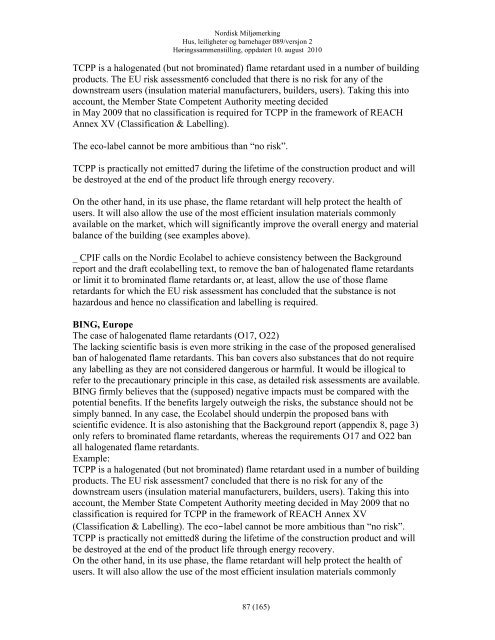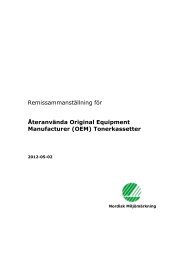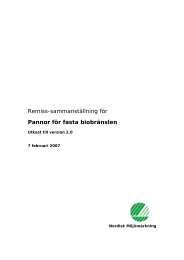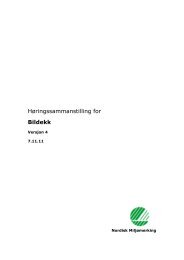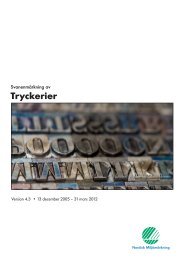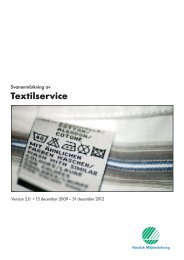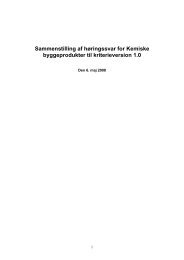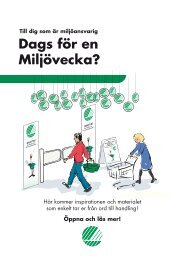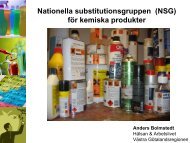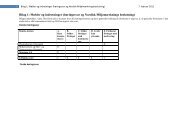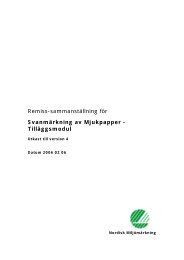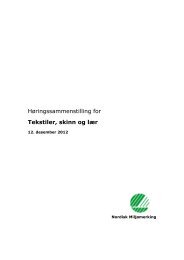Småhus, flerbostadshus och förskolebyggnader - Svanen
Småhus, flerbostadshus och förskolebyggnader - Svanen
Småhus, flerbostadshus och förskolebyggnader - Svanen
Create successful ePaper yourself
Turn your PDF publications into a flip-book with our unique Google optimized e-Paper software.
Nordisk Miljømerking<br />
Hus, leiligheter og barnehager 089/versjon 2<br />
Høringssammenstilling, oppdatert 10. august 2010<br />
TCPP is a halogenated (but not brominated) flame retardant used in a number of building<br />
products. The EU risk assessment6 concluded that there is no risk for any of the<br />
downstream users (insulation material manufacturers, builders, users). Taking this into<br />
account, the Member State Competent Authority meeting decided<br />
in May 2009 that no classification is required for TCPP in the framework of REACH<br />
Annex XV (Classification & Labelling).<br />
The eco-label cannot be more ambitious than “no risk”.<br />
TCPP is practically not emitted7 during the lifetime of the construction product and will<br />
be destroyed at the end of the product life through energy recovery.<br />
On the other hand, in its use phase, the flame retardant will help protect the health of<br />
users. It will also allow the use of the most efficient insulation materials commonly<br />
available on the market, which will significantly improve the overall energy and material<br />
balance of the building (see examples above).<br />
_ CPIF calls on the Nordic Ecolabel to achieve consistency between the Background<br />
report and the draft ecolabelling text, to remove the ban of halogenated flame retardants<br />
or limit it to brominated flame retardants or, at least, allow the use of those flame<br />
retardants for which the EU risk assessment has concluded that the substance is not<br />
hazardous and hence no classification and labelling is required.<br />
BING, Europe<br />
The case of halogenated flame retardants (O17, O22)<br />
The lacking scientific basis is even more striking in the case of the proposed generalised<br />
ban of halogenated flame retardants. This ban covers also substances that do not require<br />
any labelling as they are not considered dangerous or harmful. It would be illogical to<br />
refer to the precautionary principle in this case, as detailed risk assessments are available.<br />
BING firmly believes that the (supposed) negative impacts must be compared with the<br />
potential benefits. If the benefits largely outweigh the risks, the substance should not be<br />
simply banned. In any case, the Ecolabel should underpin the proposed bans with<br />
scientific evidence. It is also astonishing that the Background report (appendix 8, page 3)<br />
only refers to brominated flame retardants, whereas the requirements O17 and O22 ban<br />
all halogenated flame retardants.<br />
Example:<br />
TCPP is a halogenated (but not brominated) flame retardant used in a number of building<br />
products. The EU risk assessment7 concluded that there is no risk for any of the<br />
downstream users (insulation material manufacturers, builders, users). Taking this into<br />
account, the Member State Competent Authority meeting decided in May 2009 that no<br />
classification is required for TCPP in the framework of REACH Annex XV<br />
(Classification & Labelling). The eco‐label cannot be more ambitious than “no risk”.<br />
TCPP is practically not emitted8 during the lifetime of the construction product and will<br />
be destroyed at the end of the product life through energy recovery.<br />
On the other hand, in its use phase, the flame retardant will help protect the health of<br />
users. It will also allow the use of the most efficient insulation materials commonly<br />
87 (165)


